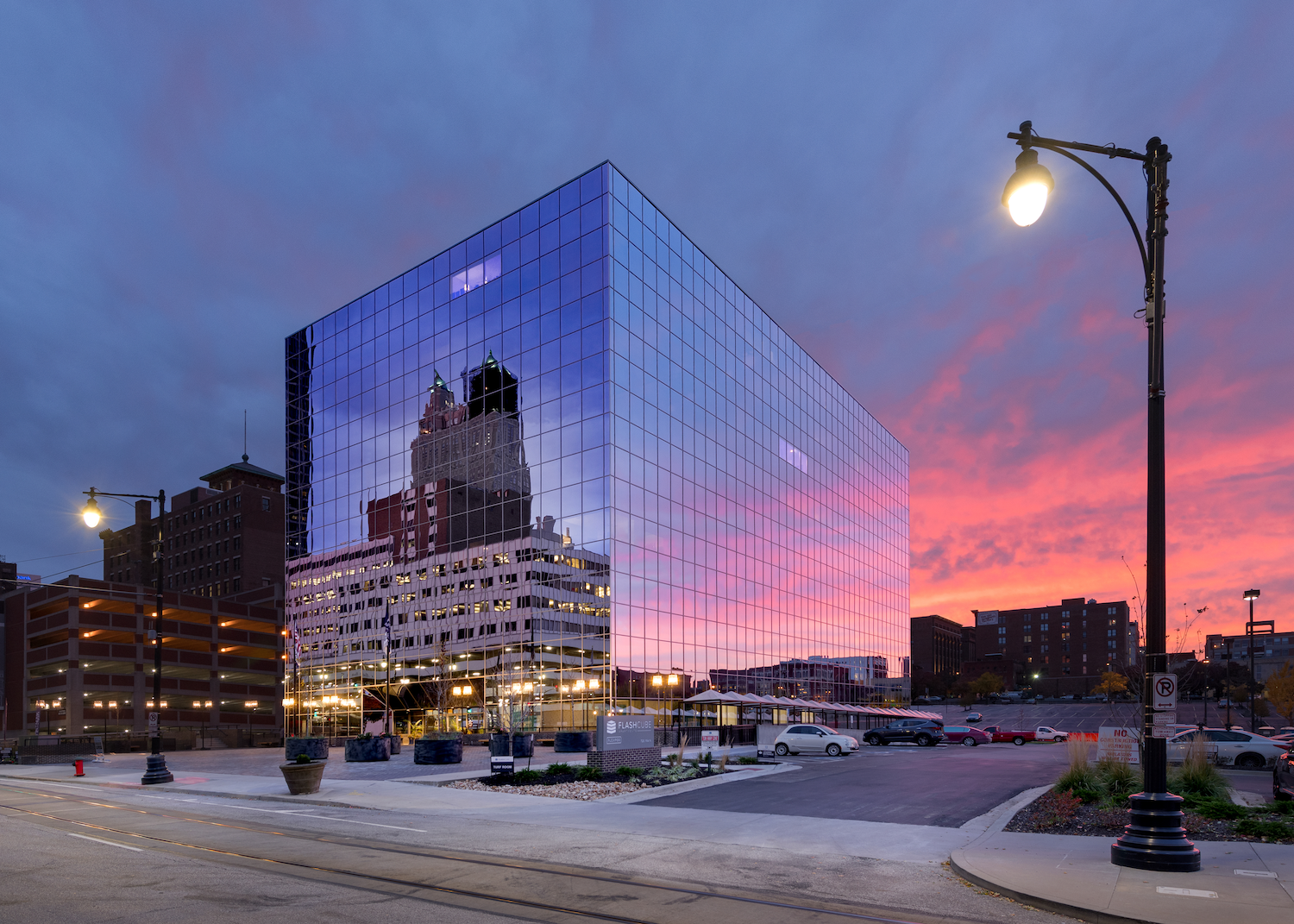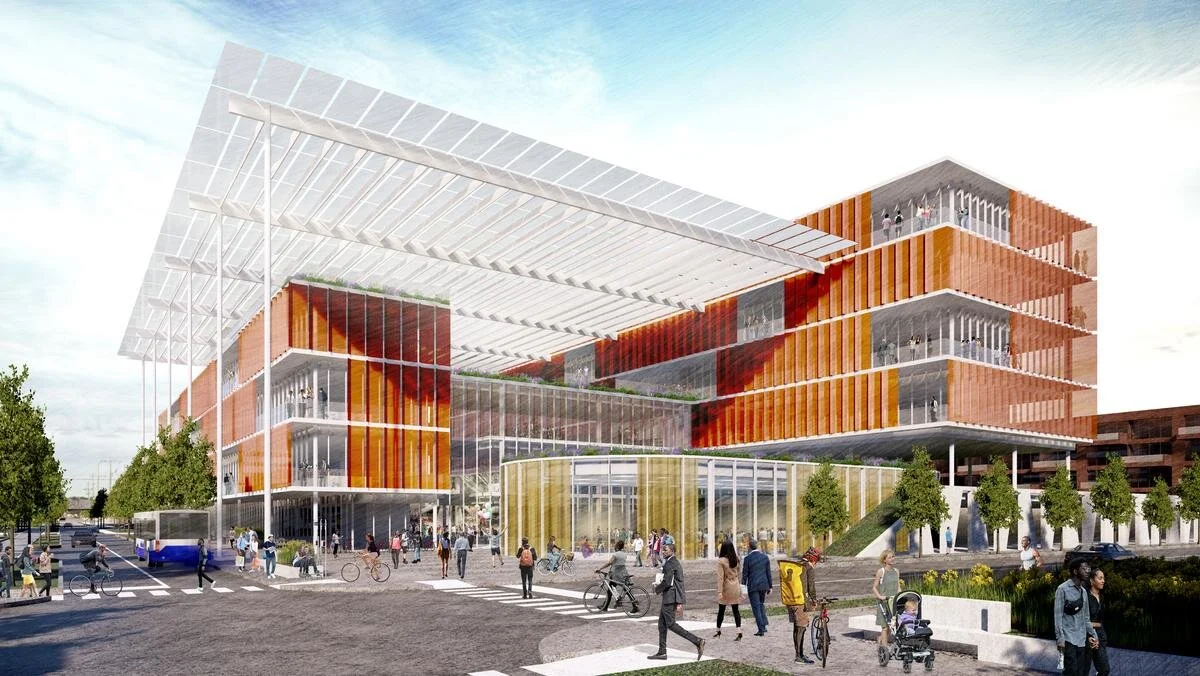Photo from left: Patrick Kantor, Marc Tower, Dan Phelan and Matt Jones. Photo credit: MWM/Marcia Charney
Flashback to the amazing Flashcube transformation
All eyes focused on Kansas City CRE wins
Last week at CCIM Kansas City’s monthly meeting, Michael Berenbom, managing partner, LANE4 Property Group; Jon Copaken, principal, Copaken Brooks; John McGurk, vice president of development, Milhaus; and Ora Reynolds, president, and CEO, Hunt Midwest, joined moderator Tim Cowden, president and CEO of Kansas City Area Development Council (KCADC), for a discussion of the state of the Kansas City market for the four major asset classes represented by the panel.
The panelists each spoke to the Kansas City projects that have them most excited. Reynolds began with Hunt Midwest’s logistics and industrial footprint and its continuing rapid growth.
“Definitely this cycle and people have written about it, is so different. The cycle there can be a two-year cycle from when you source a deal to when you build it and lease it, instead of what took a 5, 10, 15-year cycle. You tend to know what you have when you start with industrial when you start with a building. You know when the end goal is,” said Reynolds.
Berenbom said he is excited about downtown Lee’s Summit.
“Whether it’s office or retail we’re looking at, location matters, character matters, neighborhood matters, and downtown Lee’s Summit is one of those neighborhoods that has it. Sometimes it’s hard to articulate exactly what that is, but we all know if we go spend time down there,” he said.
Copaken spoke about residential development, especially downtown, which has seen continued growth. But, he’s especially pumped about the renewed discussion of a downtown baseball stadium.
“That’s the catalytic project that can really push things over the edge for the whole city. It’s good to see that there’s ownership and people actually interested in making something happen,” said Copaken.
McGurk is looking forward to the streetcar extension. He also said he’s starting to see some really healthy rent growth in the multifamily market across the entire metro area, which historically has been a cheap housing market.
“You’re also starting to see a lot of supply fall off a cliff. Five years ago you would hear of 12, 15 projects in downtown. Well, there are maybe three or four that are going to be under construction and delivering in the next three years. Supply’s really falling off which is just going to increase that rent growth . . . . It’s harder to do deals, but the juice is worth that squeeze probably,” McGurk said.
However, McGurk believes there will continue to be a demand for multifamily housing. He noted that there is a lack of availability of single-family houses, but also many millennial tenants like the multifamily lifestyle.
“They like having new, and they like having all the amenities. It’s just a different generation and I’m sure it will change. Household formation is mid-30s, late-30s now. I’m not saying we’ll have an oversupply in 15 or 20 years, but I think there’s a lot of runway still for sure in multifamily,” said McGurk.
Reynolds said the pandemic accelerated every trend for industrial, with brick and mortar retail moving to warehouse. But, the pandemic also created supply chain issues.
“It used to be all about just-in-time inventory. That was it. Let’s be efficient. Now it’s just-in-case. It’s safety stock. We need it, and we need redundancy as opposed to just in time, which has been amazing for the industrial world,” Reynolds said.
Berenbom said LANE4’s retail product held up well during COVID because LANE4 had the right type of retail assets—the neighborhood, service, convenience-based product.
“And I think that more and more we’re realizing that retail is an integral last-mile solution for a lot of people. There’s a lot of products where free delivery on your doorstep works, and we’re learning that there are some that don’t. And we’re learning other ones, like haircuts, are hard to do online,” Berenbom said.
Copaken said the effects of COVID are continuing for the office market. The uncertainty of the market makes it hard for landlords to do business, especially as tenants ponder lease renewals and change in space needs.
“I think it’s really going to be a tough year for existing landlords to keep, maintain and figure out what to do with their existing tenants. And, it’s going to be a tough year to work on new projects. The dynamics are not in our favor right now. They’re really in the favor of tenants,” Copaken said.
Copaken said his firm is trying to create environments that are unique, that people want to be part of and that tenants will pay up to be part of.
“So, we’re renovating, we’re spending money, we’re improving assets. That’s kind of the only bet we can make.. We’ve decided to put in improvements that make our older buildings as if they were new, and appeal to people who are definitely going to have to pay something more but they’re going to have to pay something more for that quality they want,” he said.
Infrastructure funds connect KC with Google Fiber
“This project for me personally has been a game-changer, and as we’ve seen, it’s been a game-changer for Kansas City,” said Rick Usher, former assistant city manager at the City of Kansas City, Missouri, and founder of The Usher Garage LLC.
The project to which Usher was referring in his virtual presentation to KC Downtowners on September 8, was bringing Google Fiber to Kansas City.
Although it’s been a decade since Google Fiber chose both Kansas City, Missouri and Kansas City, Kansas as the first communities to get its digital symmetric gigabit-speed internet service, the region has an opportunity to apply lessons learned from the Google Fiber project to benefit from the federal infrastructure bill.
“This is really a once in a century opportunity for funding of projects of this scale, so how the cities reacted to Google Fiber, how we worked with them to build out the network, these are lessons learned that can be applied to moving forward as a region with this infrastructure bill,” said Usher.
In 2010, Google Fiber announced plans to build experimental, ultra-high-speed broadband networks and released its Fiber for Communities RFI. A group of entrepreneurs at one of Kansas City’s co-working spaces (of which there were only two at the time), Office Port KC, began a response to the RFI.
Those entrepreneurs needed assistance and reached out to Cindy Circo, a member of the Kansas City Missouri City Council. The request made its way to Wayne Cauthen, then the city manager of the City of Kansas City, Missouri, who assigned Usher to help facilitate the response.
Usher said putting together the response to the RFI was a community-wide collaborative effort, with more than 117 participants contributing to the response.
Representatives from the Kansas City, Missouri proposal team first suspected that they might not be the only recipients of the Google Fiber opportunity when the receptionist at Polsinelli, where negotiations occurred, asked the Kansas City, Missouri city attorney if he was with the Unified Government of Wyandotte County.
“So we at that point started seeing that it would be two Kansas Cities in this announcement,” Usher said.
On March 30, 2011, Google Fiber announced that it would be rolling out its fiber network in Kansas City, Kansas. On May 17, 2011, Google Fiber made the award to Kansas City, Missouri.
Usher said there were discussions of a joint announcement. But, Kansas City, Kansas was able to come to an agreement with Google Fiber more quickly because its Board of Public Utilities was essentially a city department; whereas, Kansas City, Missouri had to work with Evergy.
“On the Missouri side, we were working closely with Evergy, then Kansas City Power and Light, to assist them in really vetting and doing the due diligence on how a privately-held public utility would show benefit not only to the City and the Kansas City region but to their customers and their shareholders,” said Usher.
Evergy entered an agreement with Google Fiber to allow use and access to Evergy’s utility poles and easements, which Usher said was crucial.
In September 2011, the then mayors of Kansas City, Missouri and Kansas City, Kansas formed the Bi-State Innovation Team, which was charged with figuring out how the region would be able to take advantage of this gigabit network opportunity that Google was bringing.
“So we got a lot of experience then in how cities can share the right of way, share infrastructure. As you can see now, Google Fiber and others are partnering with jurisdictions on cooperative agreements, public-private partnerships,” Usher said.
In 2012, Google’s executive chairman, Eric Schmidt, declared that the Google Fiber project was not an experiment, but was actually being run as a business. Shortly thereafter, Google Fiber announced it was expanding to Austin, Texas, and then to other cities around the country.
“Today we have 22 cities in the Kansas City region that have entered into agreements with Google Fiber,” said Usher.
Usher said the success of the region’s Google Fiber project serves as an example of the Kansas City region’s history of helping prove new ideas.
With respect to benefiting from infrastructure bill funds, Usher recommends that the region looks to more public-private partnerships with other internet providers to build out their fiber networks.
“We have a really unique situation I think in the Kansas City region on the number of internet providers we have, the quality of the services and the speeds that are offered. So partnering with them to assist any number of internet providers to complete the build-out of their gigabit infrastructure and their fiber infrastructure would be our best investment of those infrastructure dollars,” Usher said.








